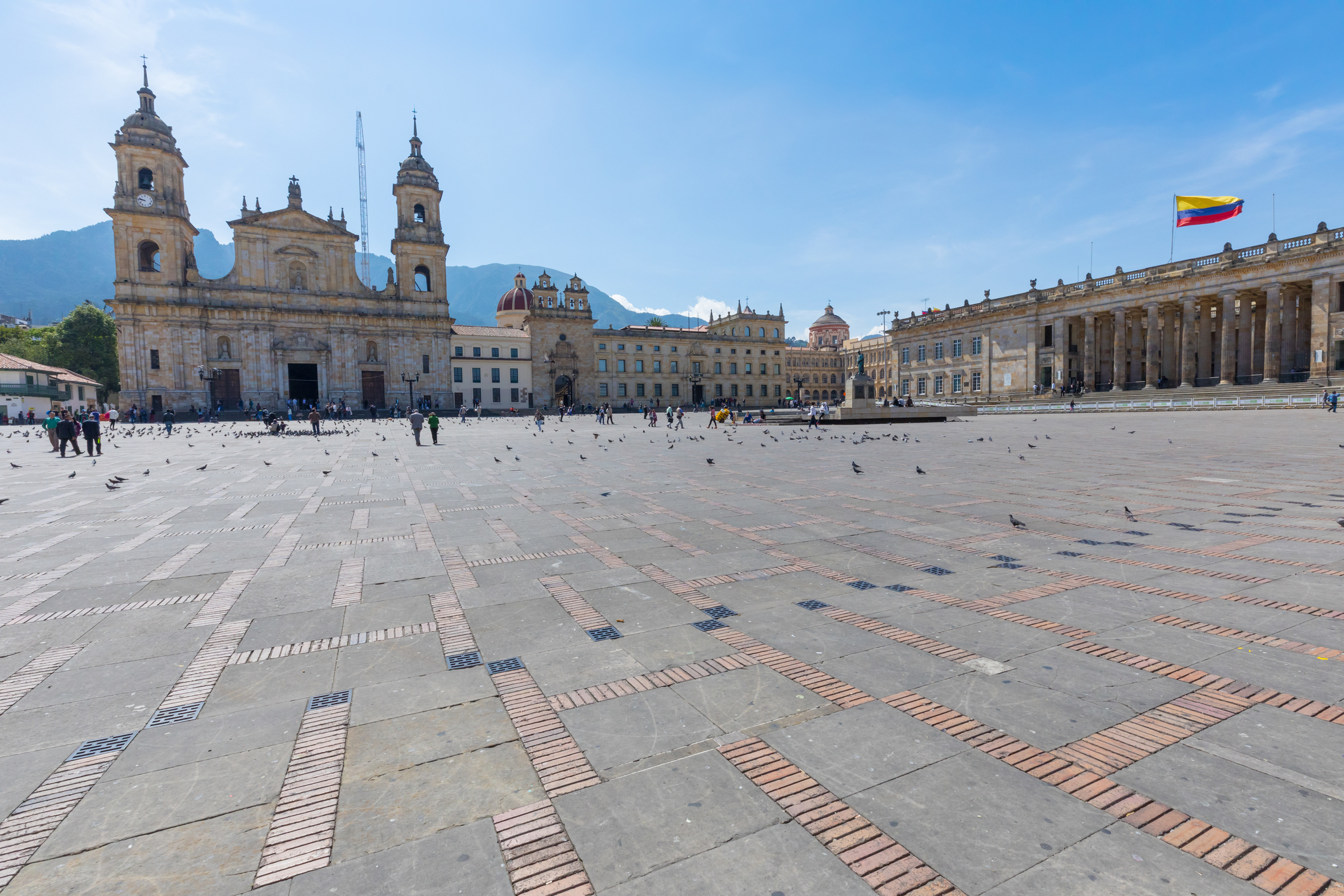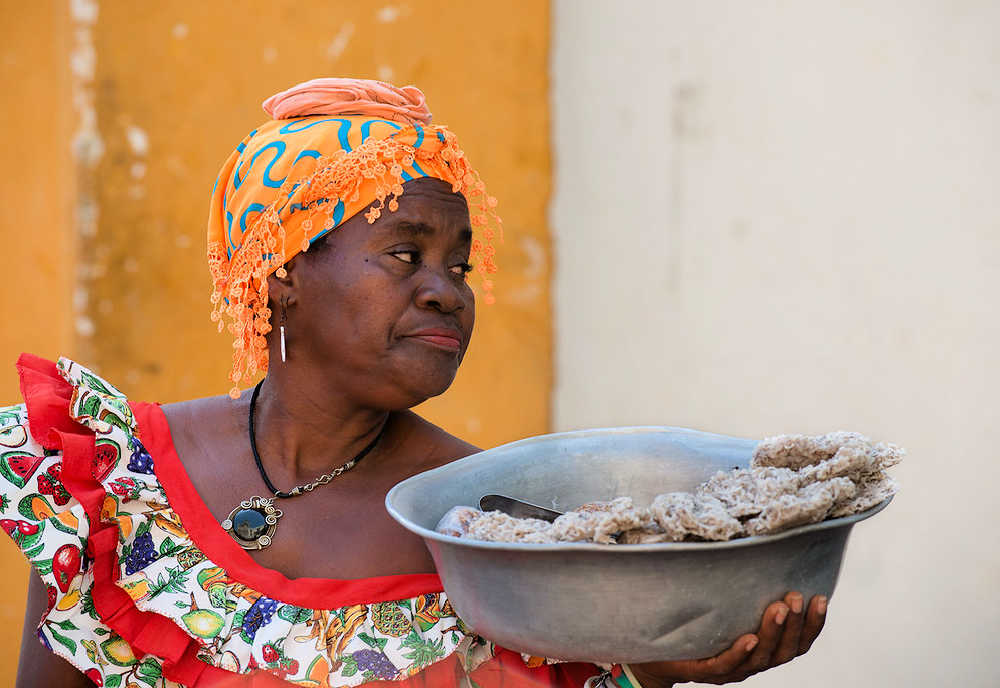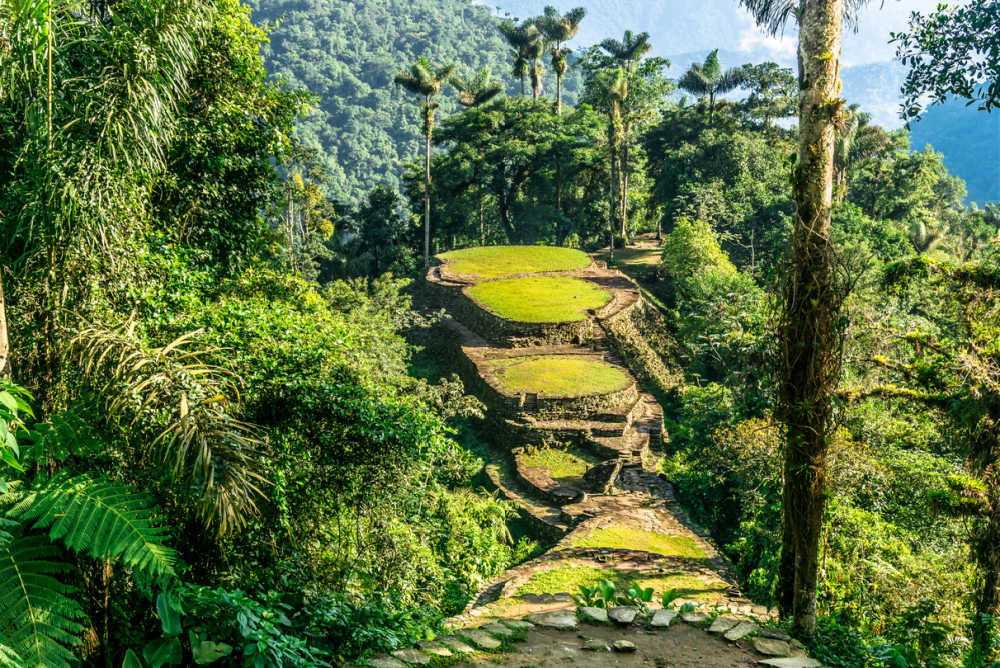Places to visit in Colombia
Brightly coloured colonial towns and vibrant (and safe) cities. Stunning coastlines (both Pacific and Caribbean) and idyllic islands. The heights of the snow-capped Andes and the depths of the coral reefs. The wildlife of the Amazon and Los Llanos and the plantation scenery of the Coffee Zone.
Colombia offers a vast array of different landscapes and experiences that will make any family holiday to Colombia exciting for all ages. There are so many family-friendly places to visit in Colombia and with a superb internal flight network, you can avoid those dreaded ‘are we nearly there yet’ road journeys. Here are some of our favourite places.

Ruins of Ciudad Perdida, thought to have been abandoned at the time of the Spanish arrival and conquest
Bogotá

Bolivar Square, Bogotá
Colombia’s capital, Bogotá, is the main international gateway to the country and most family holidays to Colombia begin here. At the centre of this lively city is the magnificent Plaza de Bolivar from where numerous lovely cobbled streets radiate out – full of slightly crumbling colonial houses, hidden churches and brightly coloured piazzas.
Located at 2,640 metres, Bogotá is a big city with over 8 million people that has 2 different faces for tourism. The old Candelaria historic district is blessed with beautiful colonial houses and stunning street art. It is home to the world-famous Museo del Oro (with its 55,000 golden artefacts) and the Botero Museum, packed full of the artist’s oversized depictions of people and animals including the amusing ‘Fat Mona Lisa’. Then there is modern Bogotá to the north where tourists will find all sorts of shops, restaurants and bars. The best way to appreciate its urban sprawl is to take the cable car to the top of Montserrate Hill for breathtaking views – quite literally at 3,150m!
Children will love visiting Paloquemao market, the most important and biggest market in the city. Here, you will be able to sample the unusual fruits, vegetables and typical Colombian food on sale – kids will enjoy tasting dragonfruits, lolas (tree tomatoes) and even the ice-cream bean!
Bolivar Square is the place to be at any time of day. Kickstart your day with a typical Bogota breakfast of hot agua de panela (sugar cane) with cheese and caldo (meat and potato soup). In the evenings, traffic is prohibited and the square comes alive with music and street food – try the empanadas (pastries stuffed with sweet or savoury fillings), arepas (filled cornmeal flatbreads) or for the sweet tooth amongst you, the famous Colombian coconut candy – bunuelos cocada.

Villa de Leyva
From Bogotá, you can take day trips to the Zipaquira Salt Cathedral, created out of salt, 180m underground. Or the quaint colonial mountain town of Villa de Leyva. Outdoor pursuits can be enjoyed in both nearby Chingaza National Park (home to the legend of El Dorado) and Chorrera Waterfall, the highest in Colombia.
Cartagena

Cartagena old town
The loveliest city in the Caribbean and one of the highlights of any family holiday to Latin America. It is a UNESCO World Heritage Site and a great place to explore on a walking or biking tour. The main centre is encircled by huge stone walls more than 13km in length and contains a wonderful maze of ancient alleyways, colonial churches, colourful piazzas, and brightly painted houses.
The Castillo San Felipe de Barajas is a fortress located on the hill of San Lázaro in a strategic location, dominating approaches to the city by land or sea. Built by the Spanish in 1536, it is a fun, family-friendly place to explore and kids will love weaving their way through the many underground passages. Other famous sites include the church of San Pedro Claver, the Palace of Inquisition, and the churches and bastions of Santo Domingo, Santiago Apostol, and San Francisco Javier.
Time in Cartagena can be spent taking a salsa class or gastronomy tour or enjoying some rum and chocolate tasting. But it is mainly about the relaxed vibe and evenings are spent strolling through the charming, romantic alleys, watching the sunset from Café del Mar, having a bite to eat in the famous La Cevicheria, one of the best ceviche and fish restaurants in the city and absorbing the nightlife of Getsemani from Café Havana.

The street food sellers in Cartagena are legendary
Coffee Zone – Salento and Cocora Valley
Colombia’s world-famous coffee growing area is a gorgeous place to sit back, relax and enjoy the stunning scenery – and the coffee of course. Salento lies in the heart of the Zona Cafetera and is one of the most beautiful villages in the region. It was once the last stop for muleteers before they headed high into the mountains and it still has a bit of a frontier feel to it. There are narrow streets lined with brightly painted buildings and a multitude of excellent cafes, artisan craft shops, and souvenir stalls.
From here you can visit one of the many local fincas (coffee farm estates) to learn about the process of producing coffee. Even though coffee can be an acquired taste for children, we do find they are fascinated by learning ‘crop to cup’ methods.

Overlooking Salento, Coffee Zone
Salento is also a great base from which to explore the stunning Cocora Valley, home to the vast wax palms (Colombia’s national tree and the tallest palm in the world) that the region is famous for. This national park is an ideal hiking or horse-riding destination. Head up through the hills and catch a glimpse of hummingbirds that flit from giant tree to tree, soaring 60m above you.
Tayrona National Park

Tayrona National Park
With over 150km² of lush jungle, sandy beaches, and a protected marine reserve, Tayrona National Park is one of the most popular places to visit in Colombia. Located 45 minutes from Santa Marta on Colombia’s Caribbean coast (or a 5hr transfer from Cartagena), Tayrona arguably has some of the best beaches and coastal panoramas in the world. This biodiverse conservation area is in the foothills of the snow-capped mountains of the Sierra Nevada, the world’s highest coastal mountain range. The park is unique in that it combines tropical rainforests and beaches with a cool mountain atmosphere and is home to over 100 species of mammals, 300 birds, 30 reptiles, numerous aquatic species, and over 770 plant species.
Sandy white beaches surrounded by mangrove swamps, bushes, and forests, bathed in the crystal-clear water of the Caribbean Sea, are all part of the many attractions in Tayrona National Park. Cabo San Juan de Guia and La Piscina, on the park’s eastern coastline, are the best beaches for swimming and kids will love snorkelling amongst the unique and protected coral in the calm waters of the many bays. Hike to the archaeological site of El Pueblito, cruise the mangroves, and chill out on the white sand of Arrecifes beach. At night, lie back in your hammock and star gaze.
Palomino
Palomino is located near Tayrona National Park on Colombia’s Caribbean coast. Palomino’s white sandy beaches have two freshwater rivers tumbling down from the Sierra Nevada to the ocean, making it a great place for tubing. Take a short hike through the rainforest up into the mountains then float down river in inner tubes until you reach the ocean. A truly relaxing and fun way to enjoy Colombia’s scenery and wildlife. Other activities include tree canopy ziplining, rock climbing, trekking to waterfalls and swimming holes, horse-riding – or take the ultimate paragliding flight mixing snowy mountains with the sparkling coastline.
Caribbean Islands
Colombia is deservedly well known for its superb islands and beaches – it’s just hard to know which ones to pick! Sometimes logistics of transfer times and method can play a part – but be assured, whichever one you choose you are guaranteed white sand, swaying palms, and sparkling turquoise seas. Baru Island is a popular choice – whether as a day trip from Cartagena or longer. Home to the famous Playa Blanca, known as one of Colombia’s most beautiful beaches, Baru may get busy with daytrippers, but by mid-afternoon, you will have the crystal-clear waters and perfect white sandy beaches to yourself.
There is a good choice of accommodation as well. Mucura Island involves a slightly longer transfer from Cartagena but the 2.5hr (sometimes rough) boat trip is worth it when you alight on this idyllic coral island, part of the San Bernardo Archipelago. The beach resort here offers a variety of nautical sports including night snorkelling amongst the bioluminescent plankton – children will absolutely love this surreal tropical experience.

St Andres and Providencia Islands
For the ultimate Caribbean spot to visit in Colombia we recommend the San Andres/Providencia Islands. Bizarrely closer to the Nicaraguan coast, these incredible islands are a short flight from Cartagena (or other Colombian cities) yet a million miles from its vibrant and bustling streets. Here you will find a different, Afro-Caribbean culture, where the main language is Creole-English.
Both are popular for their idyllic white sand beaches and outstanding underwater experiences. Scuba-dive the marine-rich underwater world of Providencia, the third largest coral reef in the world and known for its sea of seven colours. Cycle around San Andres (or make the most of the duty-free shops) and take a boat trip to iguana-rich and uber-cool Johnny Cay. Or simply chill out to the Caribbean vibe, feast on some delicious fresh fish served with arroz con coca (coconut rice), and relax into that Colombian feeling of ‘tranquilidad’.
Cali
Cali is Colombia’s third-largest city. On arrival do not be fooled into thinking you are in Rio as the gigantic statue of ‘Cristo Rey’ dominates the skyline. Cali is well-known as the salsa capital of the world. It is full of rhythm with music, live bands, and constant dancing in the street – the perfect place to learn to salsa! Wander the lanes of historic Barrio San Antonio and sample the local empanaditas and pandebono snacks.
Fans of the Netflix series ‘Narcos’ will enjoy location-spotting whilst cat lovers should visit El Gato del Rio, a pleasant riverside park full of giant feline sculptures. Children will love the day trip to San Cipriano with the chance to ride on the brujitas, motorbike-driven platforms which zip you through the jungle along old rail tracks to reach town.
Medellin

Medellin cable car
Known as ‘the City of Eternal Spring’, this city, once a ‘no-go’ zone due to the local cartel, has now blossomed into a must-see attraction on the traveller’s circuit of Colombia. The best way to explore the city is by its innovative network of cable cars known as the Metrocable – think London’s tube up in the sky! Ride from the once infamous Santo Domingo neighbourhood to Arvi Park – one moment you will have a spectacular view of the city’s skyline and the next, you will be gliding over the vast and beautiful forest of Parque Arvi.
Older families might like to tweak the traditional city tour with the somewhat unique Pablo Escobar tour which retraces key locations from the notorious ‘narco’s’ life or take a graffiti tour through the mesmerising street art of Comuna 13, once considered the most dangerous neighbourhood in the world. Or try the typical street food of the region on a culinary walking tour – ‘empanadas’ (kind of like a Cornish pasty) or ‘arepa’ (filled with homemade cottage cheese) and taste the delicious Colombian desserts. There are plenty of traditional options – some are fried, some are sweet, some are healthy – but all are delicious!

Typical Medellin mural
Medellin is also the perfect place to witness the passion Colombians have for the ‘beautiful game’ – futbol. Take in a game with Atletico Nacional and get swept away by the sheer colour, noise and exuberance of the local fans.
Guatapé

Guatapé
An easy day trip from Medellin is an excursion to the El Peñol Boulder and the picturesque town of Guatapé.
El Peñol is a huge ten million-ton rock that rears nearly 200m up out of a lush landscape of lakes and fields. There is a crack up the side of the rock, in which has been wedged a switchback staircase that you can climb for superb views. Be warned though – there are 740 steps!
Guatapé is known as the most colourful town in the world where every building is a work of art. Local residents paint their houses in gorgeous bright colours and decorate the bottom of each building with fresco-like panels called ‘zocalos’. This town, preserved in time, will keep budding photographers happy at every corner and perfectly represents the life and soul of colourful Colombia.

Los Llanos and Hato La Aurora
Los Llanos is a vast, seasonally-flooded lowland grassland to the east of the Andes mountains. The forests, lakes, and wetlands are the perfect habitat for a safari and all wildlife-mad families must include this on a Colombia family holiday itinerary. Our favourite part of these ‘Flat Plains’ is the Hato La Aurora Reserve, 17,000 acres packed full of wildlife (filmed by BCC & Animal Planet). Here, you would hope to encounter capybaras, iguanas, armadillos, sloths, pumas, jaguars, howler monkeys, and the impressive giant anteater. In the freshwater rivers and lagoons reside caimans, the endangered Orinoco crocodile, and the heaviest snake in the world, the giant anaconda, which can reach up to 6m in length.
For bird lovers out there, these rich tropical grasslands are home to both mountain and Amazonian species including the Jabiru (the tallest flying bird in Latin America), Scarlet Ibis, and the delightfully named Hoatzin (‘stinkbird’),
Activities typically include birdwatching, game drives, night safaris, walking, boat trips, piranha fishing, and horse riding across the plains. You can also see real cowboys in action, as the local ‘vagueros’, dressed in traditional ponchos and straw hats, round up their cattle. Evenings are spent around the fire, enjoying the live music, dancing, and learning about the traditional life of the Llaneros plainsmen.
Ciudad Perdida - The Lost City

Ruins of the Lost City (Ciudad Perdida)
The Lost City is Colombia’s equivalent of Machu Picchu. Located deep in the dramatic Sierra Nevada de Santa Marta mountains, the city was built in the 9th century by the indigenous Tayrona people, with a unique design that is not seen anywhere else in Latin America. It is only accessible on foot, following the ‘Lost City Trail’, an adventurous 3-4 day hike passing through the UNESCO biosphere, an area of thick tropical rainforest, tumbling rivers, and majestic mountain views.
A challenging trek, it involves numerous river crossings and a height gain of 660m. The final climb involves a gruelling ascent of 1200 steps to reach this enigmatic ruin. Sleeping in hammocks in simple rainforest cabins, this trail is more suitable for older children – or those able to cope with sometimes heavy rain, slippery paths, and the constant humidity – and will provide a real off-the-beaten-track experience for your family holiday to Colombia.
The Amazon – Leticia
Yes, along with 8 other countries in South America, Colombia also has a chunk of the Amazon. Located right in the southern tip, squished between Peru and Brazil, the Colombian Amazon does not lend itself easily to inclusion in a family holiday to Colombia. However, for avid nature lovers, it is certainly worth the effort, even if you have been to the Amazon in other countries before, as it is less visited and offers some really fascinating cultural as well as wildlife experiences. Much of it remains untouched and hundreds of new species are being discovered every year.
Fly to Leticia, known as Tres Fronteras, where open borders mean you can have breakfast in Colombia, lunch in Peru, and an evening caipirinha cocktail in Brazil. From here you can head to Reserva Natural Tanimboca, a private reserve of secondary-growth forest, known for its exciting canopy and zip-wire walkway. Overnight in a rustic treehouse in the middle of the jungle (not for the critter-wary!) then continue to the nature reserve of Isla de los Micos, known for its squirrel monkeys.

Amazon River at Leticia
Further upriver is Lago Tarapoto, an oxbow lake where the mystical ‘boto’ or pink dolphin resides. It is also a good place to spot macaws and camungo (the ‘horned screamer’) as well as the giant Victoria Amazonica water lily.
With the country off limits for so long, Colombia is a relatively new arrival to Amazonian tourism and it is heart-warming to see that environmental concerns and responsible travel methods are taking priority over commercialisation and profits. A visit to the indigenous communities provides a fascinating insight into local traditions and jungle life. In the settlements of Macedonia and Puerto Nariño, you can observe locals fishing in a time-old manner, learn about Ticuna mythology, and witness their artistry from basket-weaving to tapestries and wood sculpture.

Puerta Nariño
Call us and we will be happy to provide you with a free-of-charge no obligation itinerary and quotation designed for you.
01728 752751
Colombia in pictures


